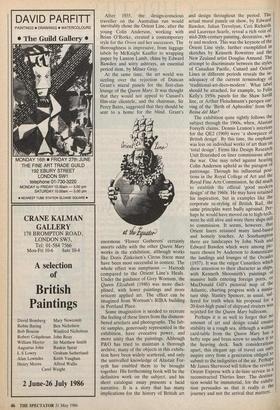Exhibitions
Art on the Liners (Southampton Art Gallery till 29 June)
Travelling in style
Alan Powers
When the Titanic sank in 1912, there was no cause to mourn the lost works of art on board, for liners of the Edwardian era did their best to resemble rather stUffY country house interiors, carried out by high-class trade decorators. Twenty-five years later, the shipping lines of Britain were competing with each other and the rest of the world to produce interiors not only luxurious but chic, designed by fashionable young architects. The Queen Mary or the Orion would have taken to the ocean's bed acres of mural painting, de- corative glass, relief carving, specially de- signed furniture, fabrics, cutlery, crockery and ashtrays. These are some of the items assembled in the exhibition appropriately held in Southampton. The result is a microcosm of British design in the period 1930-1960, from Brangwyn's murals on the Empress of Britain to Hockney's 'Pop Inn' disco on the Canberra. Although the profession of de- signer hardly existed in England, interna- tional travellers were sufficiently sophisti- cated to choose their line according to the visual surroundings. Ships like the German Bremen and the French Normandie wooed them with classicial austerity or 0 art-deco profusion, and the exhibition shows the attempt to win them back. After 1935, the design-conscious traveller on the Australian run would inevitably chose the Orient Line, after the young Colin Anderson, working with Brian O'Rorke, created a contemporary style for the Orion and her successors. The thoroughness is impressive, from luggage labels by McKnight Kauffer to wrapping paper by Lunton Lamb, china by Edward Bawden and witty ashtrays, an essential period item, by Milner Gray.
At the same time, the art world was sizzling over the rejection of Duncan Grant's mural panels for the first-class lounge of the Queen Mary. It was thought that they would not appeal to Cunard's film-star clientele, and the chairman, Sir Percy Bates, suggested that they should be sent to a home for the blind. Grant's enormous 'Flower Gatherers' certainly assorts oddly with the other Queen Mary works in the exhibition, although works like Doris Zinkeisen's Circus frieze must have been most successful in context. The whole effect was sumptuous — Harrods compared to the Orient Line's Heals. Under the guidance of Grey Wornum, the Queen Elizabeth (1946) was more disci- plined, with fewer paintings and more reticent applied art. The effect can be imagined from Wornum's RIBA building in Portland Place.
Some imagination is needed to recreate the feeling of these liners from the dismem- bered artefacts and photographs. The fab- ric samples, generously represented in the exhibition, have evocative power, and more unity than the paintings. Although P&O has tried to maintain a thorough archive, many of the objects in this exhibi- tion have been widely scattered, and only the unrivalled knowledge of Alastair For- syth has enabled them to be brought together. His forthcoming book will be the definitive work on the subject, and his short catalogue essay presents a lucid narrative. It is a story that has many implications for the history of British art and design throughout the period. The actual mural panels on show, by Edward Bawden, Julian Trevelyan, Ceri Richards and Laurence Scarfe, reveal a rich vein of mid-20th-century painting, decorative, wit- ty and modern. This was the keynote of the Orient Line style, further exemplified in sketches by Kenneth Rowntree and the New Zealand artist Douglas Annand. The attempt to discriminate between the styles of Canadian Pacific, Cunard and Orient Lines at different periods reveals the in- adequacy of the current terminology of `traditional-art-deco-modern'. What label should be attached, for example, to Felix Kelly's 1950s panels for the Shaw Savill line, or Arthur Fleischmann's perspex car- ving of the 'Birth of Aphrodite' from the Reina del Mar?
The exhibition quite rightly follows the subject through the 1960s, when, Alastair Forsyth claims, Dennis Lennon's interiors for the QE2 (1969) were 'a showpiece of British design'. By this time, the emphasis was less on individual works of art than on `total design'. Firms like Design Research Unit flourished on liner commissions after the war. One may rebel against hearing Colin Anderson upheld as the paragon of patronage. Through his influential posi- tions in the Royal College of Art and the Royal Fine Arts Commission, he did much to establish the official 'good modern design' of the 1960s. He may have retained his inspiration, but in examples like the corporate re-styling of British Rail, the same principles went badly aground. Per- haps he would have moved on to high-tech, were he still alive and were there ships still to commission. It seems, however, that Orient liners retained many land-based and homely touches. At Southampton there are landscapes by John Nash and Edward Bawden which were among pic- tures chosen by Anderson to domesticate the landings and lounges of the Orcades (1937). It was the vulgar Cunarders which drew attention to their character as ships, with Kenneth Shoosmith's paintings of massive hulls entering foreign ports, or MacDonald Gill's pictorial map of the Atlantic, charting progress with a minia- ture ship. Stanley Spencer, as usual, suf- fered for truth when his proposal for a 20-foot-high panel of shipyard riveters was rejected for the Queen Mary ballroom.
Perhaps it is as well to forget that no amount of art and design could ensure stability in a rough sea, although a walnut card-table from the Queen Mary has a hefty rope and brass screw to anchor it to the heaving deck. Such considerations apart, this elegant age of travel can only inspire envy from a generation obliged to submit to the indignities of the air. Perhaps Mr James Sherwood will follow the revived Orient Express with a de-luxe service in a reconstructed Thirties liner. The destina- tion would be immaterial, for the exhibi- tion persuades us that it really is the journey and not the arrival that matters.



























































 Previous page
Previous page